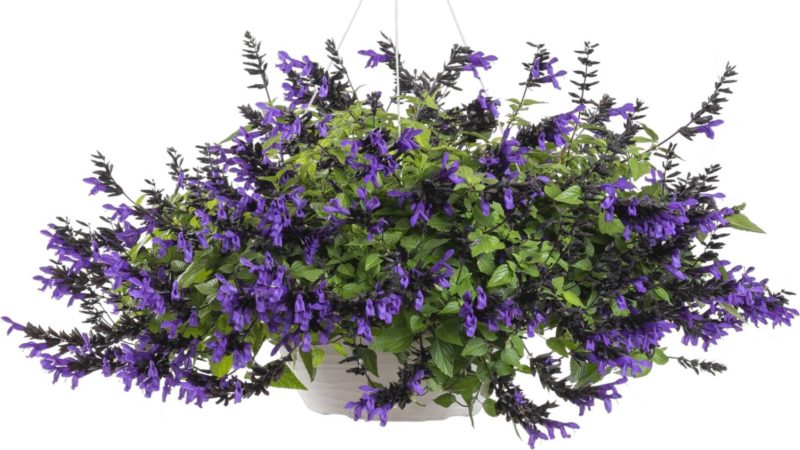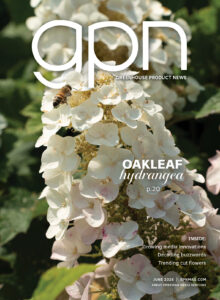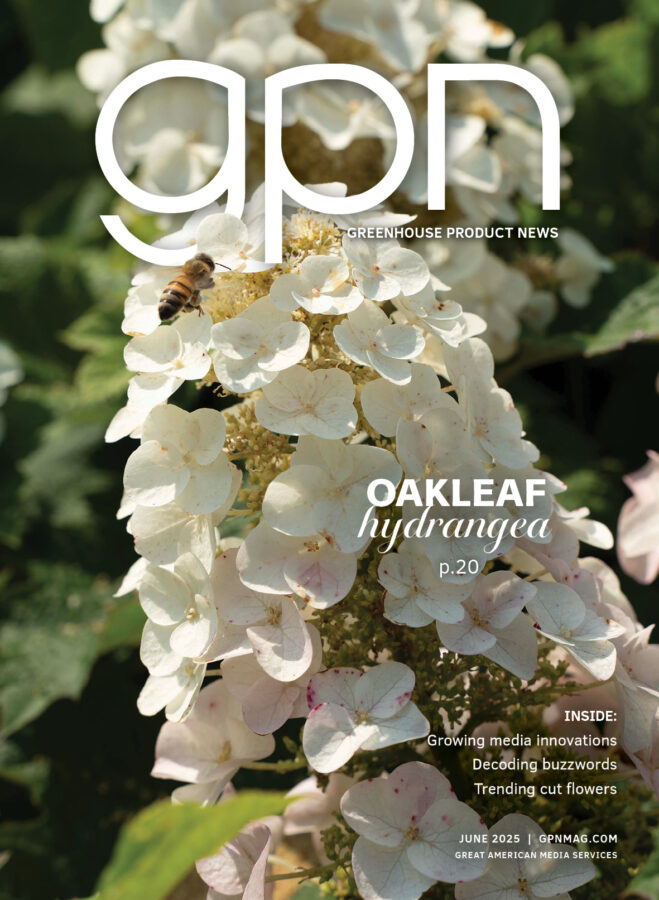
Culture Report: Salvia ‘Hummingbird Falls’
‘Hummingbird Falls’ is an absolute breeding breakthrough for Salvia guarantica hybrids. This new introduction is the first trailing variety of its kind, producing cascades of pulsating blue flowers emerging from glistening black calyces and stems. As the name would suggest, ‘Hummingbird Falls’ is a natural magnet for hummingbirds and will be well suited for today’s consumers looking for eco-positive products to make a beneficial impact on their garden environment.
Large hanging baskets of ‘Hummingbird Falls’ will be a massive hit at retail, where the plant can be marketed as a natural hummingbird feeder, replacing the traditional glass feeders filled with artificial sweeteners. And like other guarantica varieties, ‘Hummingbird Falls’ is impervious to heat and humidity, making it an easy consumer success story. It does prefer warmer temperatures, so we suggest planning ‘Hummingbird Falls’ for late spring through summer sales opportunities.
‘Hummingbird Falls’ is a vigorous variety with a fast finish, so we recommend using it in gallon containers or in large hanging baskets for a truly dramatic display. In baskets, we love pairing it with other vigorous counterparts like the electric lime color of ‘Marguerite’ ipomoea for an unstoppable summer combination. In the landscape, plant ‘Hummingbird Falls’ where it can naturally cascade over walls, or let it spread as a natural groundcover where it will be covered in a profusion of dazzling blue blooms throughout the summer.
PROPAGATION GUIDE
‘Hummingbird Falls’ is available as both unrooted cuttings or rooted liners. Unrooted cuttings are available exclusively through Dümmen Orange in North America and can be purchased through any broker.
- Appropriate tray cell sizes: 50, 72, 84
- Rooting hormone: Yes
- Average time under mist: 10 to 14 days
- Pinch: Yes
- Propagation time: 4 to 6 weeks
GROWING ON
‘Hummingbird Falls’ is a vigorous variety with a fast finish for season-extending programs. It is important to maintain control of the plants with high light levels, pinching and growth regulators. Also choose a larger container size, and use other vigorous heat-loving varieties in combination with ‘Hummingbird Falls’.
Use a well-drained media and allow for slight wilting between waterings. It is especially important to allow the media to dry down between irrigations during the cooler, more cloudy production months of February and March to eliminate any disease concerns.
Recommended soil pH is 5.4 to 5.8. Light levels should be 7,000 to 9,000 foot-candles.
GROWING TEMPERATURES
Recommended temperature is 70 to 78° F days and 60 to 64° F nights. ‘Hummingbird Falls’ prefers warm temperatures to flower early in the growing schedule.
FERTILIZATION
‘Hummingbird Falls’ will need consistent feed to avoid yellowing leaves. Fertilize every other irrigation 175- to 225-ppm nitrogen using a well-balanced, nitrate-based feed that includes micros. Periodic leaching will help maintain an EC no higher than 1.0. Maintain a pH in the 6.0 to 6.5 range.
PINCHING
It is important to pinch ‘Hummingbird Falls’ to maintain a well-rounded shape and more branching for increased flowering. Liners should be pinched during the propagation phase, otherwise pinch immediately at transplant. The plants will benefit from one to two further pinches during the growing phase two to three weeks after transplant.
GROWTH REGULATION
‘Hummingbird Falls’ is a vigorous variety that benefits from growth regulators. However, it is important to not over treat the plants in hanging baskets, which would cause them to lose their overall cascading habits. We recommend a spray three weeks after transplant of B-Nine at 2,500 ppm with Cycocel at 750 ppm.
PESTS AND DISEASES
Salvia can suffer from whitefly, fungus gnats and thrips, as well as Botrytis, Pythium, and Rhizoctonia. Allow media to dry down between waterings, particularly under cooler conditions to avoid these issues.
CROP TIME
Crop time for gallons is eight to 10 week with one to two plants per pot. For hanging baskets, crop time is 10 to 12 weeks with three plants per pot.









 Video Library
Video Library 


















